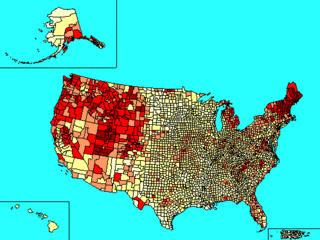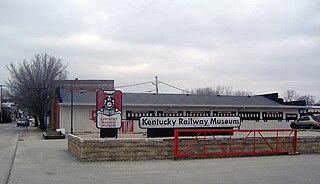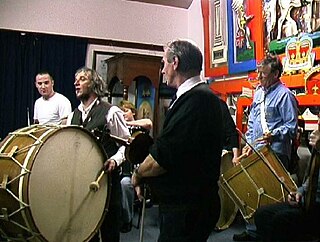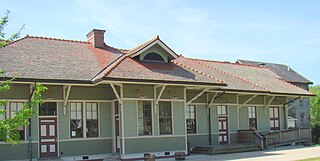
James Guthrie was an American lawyer, plantation owner, railroad president and Democratic Party politician in Kentucky. He served as the 21st United States Secretary of the Treasury under Presidents Franklin Pierce and James Buchanan, and then became president of the Louisville and Nashville Railroad. After serving, part-time, in both houses of the Kentucky legislature as well as Louisville's City Council before the American Civil War, Guthrie became one of Kentucky's United States senators in 1865. Guthrie strongly opposed proposals for Kentucky to secede from the United States and attended the Peace Conference of 1861. Although he sided with the Union during the Civil War, he declined President Abraham Lincoln's offer to become the Secretary of War. As one of Kentucky's senators after the war, Guthrie supported President Andrew Johnson and opposed Congressional Reconstruction.

The Louisville and Nashville Railroad, commonly called the L&N, was a Class I railroad that operated freight and passenger services in the southeast United States.

The Battle of Munfordville was an engagement in Munfordville, Kentucky during the American Civil War. Victory there allowed the Confederates to temporarily strengthen their hold on the region and impair Union supply lines.
Scotch-Irish Americans are American descendants of primarily Ulster Scots people who emigrated from Ulster to the United States during the 17th, 18th, and 19th centuries. Their ancestors had originally migrated to Ulster, mainly from the Scottish Lowlands and Northern England in the 17th century. In the 2017 American Community Survey, 5.39 million reported Scottish ancestry, an additional 3 million identified more specifically with Scotch-Irish ancestry, and many people who claim "American ancestry" may actually be of Scotch-Irish ancestry.

The history of Louisville, Kentucky spans nearly two-and-a-half centuries since its founding in the late 18th century. The geology of the Ohio River, with but a single series of rapids midway in its length from the confluence of the Monongahela and Allegheny rivers to its union with the Mississippi, made it inevitable that a town would grow on the site. The town of Louisville, Kentucky was chartered there in 1780. From its early days on the frontier, it quickly grew to be a major trading and distribution center in the mid-19th century and an important industrial city in the early 20th. The city declined in the mid-20th century, but by the late 20th, it was revitalized as a culturally-focused mid-sized American city.

Scottish Americans or Scots Americans are Americans whose ancestry originates wholly or partly in Scotland. Scottish Americans are closely related to Scotch-Irish Americans, descendants of Ulster Scots, and communities emphasize and celebrate a common heritage. The majority of Scotch-Irish Americans originally came from Lowland Scotland and Northern England before migrating to the province of Ulster in Ireland and thence, beginning about five generations later, to North America in large numbers during the eighteenth century. The number of Scottish Americans is believed to be around 25 million, and celebrations of Scottish identity can be seen through Tartan Day parades, Burns Night celebrations, and Tartan Kirking ceremonies.

The Kentucky Railway Museum, now located in New Haven, Kentucky, United States, is a non-profit railroad museum dedicated to educating the public regarding the history and heritage of Kentucky's railroads and the people who built them. Originally created in 1954 in Louisville, Kentucky, the museum is at its third location, in extreme southern Nelson County. It is one of the oldest railroad stations in the United States.

Limerick is a neighborhood one mile south of downtown Louisville, Kentucky, USA.
Irish-Scots are people in Scotland who have Irish ancestry. Although there has been migration from Ireland to Scotland and elsewhere in Britain for millennia, Irish migration to Scotland increased in the nineteenth century, and was highest following the Great Famine and played a major role, even before Catholic Emancipation in 1829, in rebuilding and re-establishing the formerly illegal Catholic Church in Scotland following centuries of religious persecution. In this period, the Irish typically settled in urban slum neighborhoods and around industrial areas. Irish ancestry is by far the most common foreign ancestry in Scotland.

John LaRue Helm was the 18th and 24th governor of the U.S. Commonwealth of Kentucky, although his service in that office totaled less than fourteen months. He also represented Hardin County in both houses of the Kentucky General Assembly and was chosen to be the Speaker of the Kentucky House of Representatives four times. In 1838, his sole bid for federal office ended in defeat when his opponent, Willis Green, was elected to the U.S. House of Representatives.

A Lambeg drum is a large drum, beaten with curved malacca canes. It is used primarily in Northern Ireland by Unionists and the Orange Order traditionally in street parades held in the summer, particularly on and around 12 July. The weight of the drum means that it had been replaced with smaller replicas for most parades, but the full-sized instrument has started to reappear in recent years - usually on floats. It is also used by the Ancient Order of Hibernians, having historical significance for parts of the nationalist community, as well.

The Norse–Gaels were a people of mixed Gaelic and Norse ancestry and culture. They emerged in the Viking Age, when Vikings who settled in Ireland and in Scotland became Gaelicised and intermarried with Gaels. The Norse–Gaels dominated much of the Irish Sea and Scottish Sea regions from the 9th to 12th centuries. They founded the Kingdom of the Isles, the Kingdom of Dublin, the Lordship of Galloway, and briefly ruled the Kingdom of York. The most powerful Norse–Gaelic dynasty were the Uí Ímair or House of Ivar.

The prehistory and history of Kentucky span thousands of years, and have been influenced by the state's diverse geography and central location. Archaeological evidence of human occupation in Kentucky begins approximately 9,500 BCE. A gradual transition began from a hunter-gatherer economy to agriculture c. 1800 BCE. Around 900 CE, the Mississippian culture took root in western and central Kentucky; the Fort Ancient culture appeared in eastern Kentucky. Although they had many similarities, the Fort Ancient culture lacked the Mississippian's distinctive, ceremonial earthen mounds.

Louisville in the American Civil War was a major stronghold of Union forces, which kept Kentucky firmly in the Union. It was the center of planning, supplies, recruiting and transportation for numerous campaigns, especially in the Western Theater. By the end of the war, Louisville had not been attacked once, although skirmishes and battles, including the battles of Perryville and Corydon, Indiana, took place nearby.

The Upland South and Upper South are two overlapping cultural and geographic subregions in the inland part of the Southern United States. They differ from the Deep South and Atlantic coastal plain by terrain, history, economics, demographics, and settlement patterns.

Scottish Canadians are people of Scottish descent or heritage living in Canada. As the third-largest ethnic group in Canada and amongst the first Europeans to settle in the country, Scottish people have made a large impact on Canadian culture since colonial times. According to the 2016 Census of Canada, the number of Canadians claiming full or partial Scottish descent is 4,799,010, or 13.93% of the nation's total population. Prince Edward Island has the highest population of Scottish descendants at 41%.

The Ulster-Scots Folk Orchestra is a Northern Irish band of musicians who perform music from the Ulster-Scots tradition. Formed in 2000, the USFO are part of a revival of interest in Ulster Scots dialect and culture that developed during the 1990s. They are involved in community music-making, including gospel-singing, fiddling, piping, flute and accordion bands, drumming and fifing.

The history of slavery in Kentucky dates from the earliest permanent European settlements in the state, until the end of the Civil War. In 1830, enslaved African Americans represented 24 percent of Kentucky's population, a share that declined to 19.5 percent by 1860, on the eve of the Civil War. Most enslaved people were concentrated in the cities of Louisville and Lexington and in the hemp- and tobacco-producing Bluegrass Region and Jackson Purchase. Other enslaved people lived in the Ohio River counties, where they were most often used in skilled trades or as house servants. Relatively few people were held in slavery in the mountainous regions of eastern and southeastern Kentucky, where they served primarily as artisans and service workers in towns.

George Dennison Prentice was an American newspaper editor, writer and poet who built the Louisville Journal into a major newspaper in Louisville, Kentucky, and the Ohio River Valley, in part by the virulence and satire in its editorials, which some blamed for a bloody election day riot in 1855. A slaveholder, Prentice initially supported Unionist candidate John Bell in the 1860 U.S. presidential election, and after the American Civil War, he urged Kentucky to remain neutral. Both of his sons joined the Confederate States Army, one dying in 1862, and Prentice's editorials lampooned Kentucky's military governor, Union General Stephen G. Burbridge. Prentice later opposed Congressional Reconstruction. He wrote a biography of Henry Clay published in 1831, an 1836 poem published in the McGuffey Readers, and a collection of his humorous essays was published in 1859 and revised after his death.

Stanford L&N Railroad Depot, also known as Baughman's Mill and Stanford Railroad Depot, is a historic train depot located in Stanford, Kentucky. It was built in 1911 and was used by the Louisville and Nashville Railroad.



















